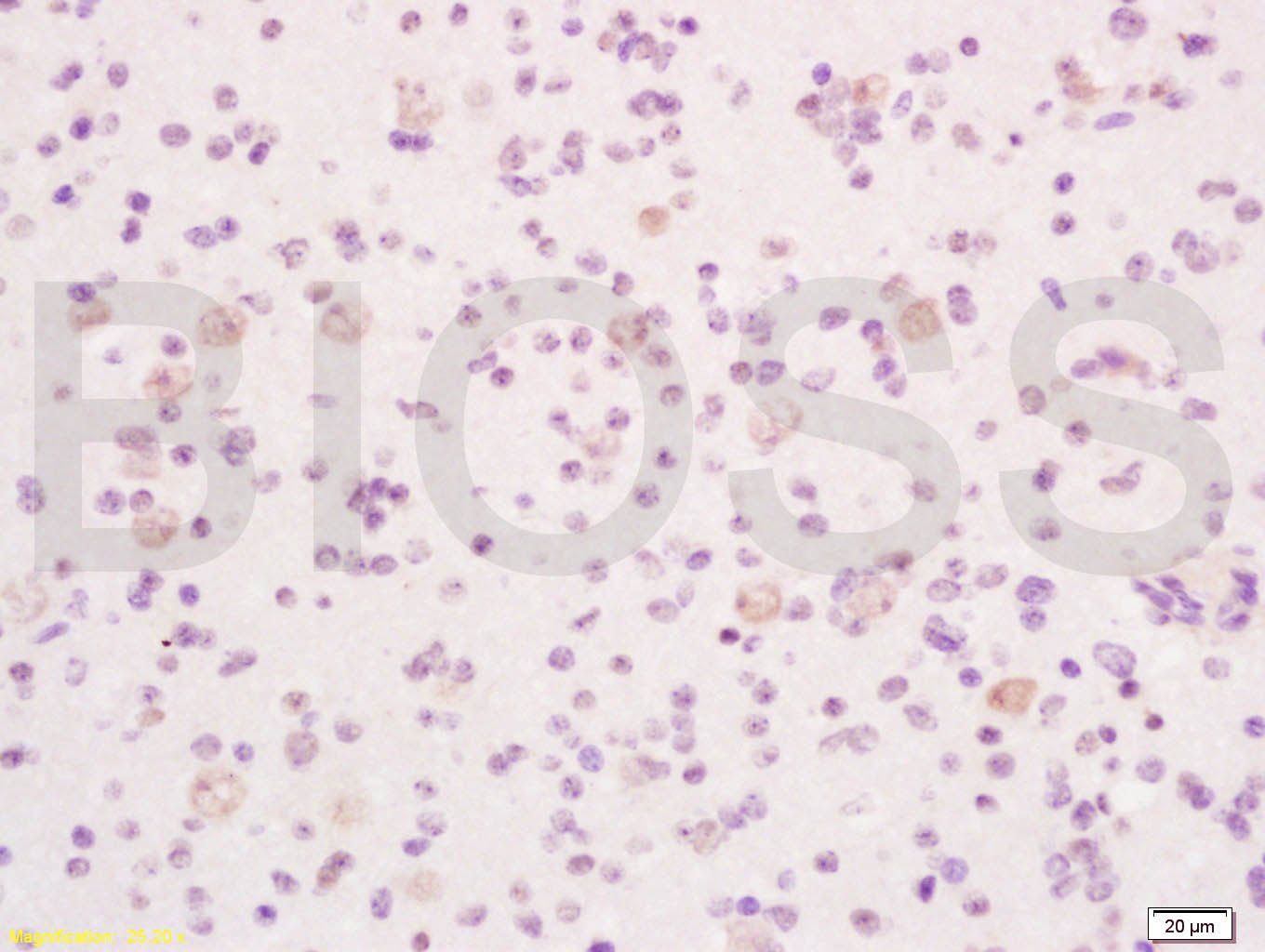
Rabbit Anti-phospho-LKB1 (Thr363)antibody
LKB 1; LKB1; NY REN 19 antigen; Peutz Jeghers syndrome; PJS; Serine/Threonine Kinase 11; Serine/threonine protein kinase 11; Serine/threonine protein kinase LKB1; STK 11; STK11; STK11_HUMAN.
View History [Clear]
Details
Product Name phospho-LKB1 (Thr363) Chinese Name 磷酸化丝氨酸/苏氨酸蛋白激酶抗体 Alias LKB 1; LKB1; NY REN 19 antigen; Peutz Jeghers syndrome; PJS; Serine/Threonine Kinase 11; Serine/threonine protein kinase 11; Serine/threonine protein kinase LKB1; STK 11; STK11; STK11_HUMAN. Product Type Phosphorylated anti Research Area Tumour Cell biology immunology Neurobiology Signal transduction Apoptosis Cyclin Kinases and Phosphatases Immunogen Species Rabbit Clonality Polyclonal React Species Human, (predicted: Mouse, Rat, Chicken, Dog, Cow, Horse, ) Applications ELISA=1:5000-10000 IHC-P=1:100-500 IHC-F=1:100-500 IF=1:100-500 (Paraffin sections need antigen repair)
not yet tested in other applications.
optimal dilutions/concentrations should be determined by the end user.Theoretical molecular weight 48kDa Cellular localization The nucleus cytoplasmic The cell membrane Form Liquid Concentration 1mg/ml immunogen KLH conjugated Synthesised phosphopeptide derived from human LKB1 around the phosphorylation site of Thr363: IY(p-T)QD Lsotype IgG Purification affinity purified by Protein A Buffer Solution 0.01M TBS(pH7.4) with 1% BSA, 0.03% Proclin300 and 50% Glycerol. Storage Shipped at 4℃. Store at -20 °C for one year. Avoid repeated freeze/thaw cycles. Attention This product as supplied is intended for research use only, not for use in human, therapeutic or diagnostic applications. PubMed PubMed Product Detail This gene, which encodes a member of the serine/threonine kinase family, regulates cell polarity and functions as a tumor suppressor. Mutations in this gene have been associated with Peutz-Jeghers syndrome, an autosomal dominant disorder characterized by the growth of polyps in the gastrointestinal tract, pigmented macules on the skin and mouth, and other neoplasms. Alternate transcriptional splice variants of this gene have been observed but have not been thoroughly characterized. [provided by RefSeq, Jul 2008].
Function:
Tumor suppressor serine/threonine-protein kinase that controls the activity of AMP-activated protein kinase (AMPK) family members, thereby playing a role in various processes such as cell metabolism, cell polarity, apoptosis and DNA damage response. Acts by phosphorylating the T-loop of AMPK family proteins, leading to promote their activity: phosphorylates PRKAA1, PRKAA2, BRSK1, BRSK2, MARK1, MARK2, MARK3, MARK4, NUAK1, NUAK2, SIK1, SIK2, SIK3 and SNRK but not MELK. Also phosphorylates non-AMPK family proteins such as STRADA and possibly p53/TP53. Acts as a key upstream regulator of AMPK by mediating phosphorylation and activation of AMPK catalytic subunits PRKAA1 and PRKAA2: it thereby regulates inhibition of signaling pathways that promote cell growth and proliferation when energy levels are low, glucose homeostasis in liver, activation of autophagy when cells undergo nutrient deprivation, B-cell differentiation in the germinal center in response to DNA damage. Also acts as a regulator of cellular polarity by remodeling the actin cytoskeleton. Required for cortical neurons polarization by mediating phosphorylation and activation of BRSK1 and BRSK2, leading to axon initiation and specification. Involved in DNA damage response: interacts with p53/TP53 and recruited to the CDKN1A/WAF1 promoter to participate to transcription activation. Able to phosphorylate p53/TP53; the relevance of such result in vivo is however unclear and phosphorylation may be indirect and mediated by downstream STK11/LKB1 kinase NUAK1 Also acts as a mediator p53/TP53-dependent apoptosis via interaction with p53/TP53: translocates to mitochondrion during apoptosis and regulates p53/TP53-dependent apoptosis pathways.
Subunit:
Catalytic component of a trimeric complex composed of STK11/LKB1, STRAD (STRADA or STRADB) and CAB39/MO25 (CAB39/MO25alpha or CAB39L/MO25beta): the complex tethers STK11/LKB1 in the cytoplasm and stimulates its catalytic activity. Found in a ternary complex composed of SMAD4, STK11/LKB1 and STK11IP. Interacts with p53/TP53, SMAD4, STK11IP and WDR6.
Subcellular Location:
Nucleus. Cytoplasm. Membrane. Mitochondrion. Note=A small fraction localizes at membranes. Relocates to the cytoplasm when bound to STRAD (STRADA or STRADB) and CAB39/MO25 (CAB39/MO25alpha or CAB39L/MO25beta). Translocates to mitochondrion during apoptosis.
Tissue Specificity:
Ubiquitously expressed. Strongest expression in testis and fetal liver.
Post-translational modifications:
Phosphorylated by ATM at Thr-363 following ionizing radiations (IR). Phosphorylation at Ser-428 by RPS6KA1 and/or some PKA is required to inhibit cell growth. Phosphorylation at Ser-428 is also required during neuronal polarization to mediate phosphorylation of BRSK1 and BRSK2.
DISEASE:
Defects in STK11 are a cause of Peutz-Jeghers syndrome (PJS) [MIM:175200]. PJS is a rare hereditary disease in which there is predisposition to benign and malignant tumors of many organ systems. PJS is an autosomal dominant disorder characterized by melanocytic macules of the lips, multiple gastrointestinal hamartomatous polyps and an increased risk for various neoplasms, including gastrointestinal cancer.
Defects in STK11 have been associated with testicular tumors (TEST) [MIM:273300]. A common solid malignancy in males. Germ cell tumors of the testis constitute 95% of all testicular neoplasms.
Note=Defects in STK11 are associated with some sporadic cancers, especially lung cancers. Frequently mutated and inactivated in non-small cell lung cancer (NSCLC). Defects promote lung cancerigenesis process, especially lung cancer progression and metastasis. Confers lung adenocarcinoma the ability to trans-differentiate into squamous cell carcinoma. Also able to promotes lung cancer metastasis, via both cancer-cell autonomous and non-cancer-cell autonomous mechanisms.
Similarity:
Belongs to the protein kinase superfamily. CAMK Ser/Thr protein kinase family. LKB1 subfamily.
Contains 1 protein kinase domain.
SWISS:
Q15831
Gene ID:
6794
Database links:Entrez Gene: 6794 Human
Entrez Gene: 20869 Mouse
Omim: 602216 Human
SwissProt: Q15831 Human
SwissProt: Q9WTK7 Mouse
Unigene: 515005 Human
LKB1基因是一种抑癌基因,也是一种丝氨酸/苏氨酸蛋白激酶.LKB1的功能主要是使细胞周期阻滞在G1期、促进Apoptosis和调节胚胎血管形成等.LKB1基因的胚系突变是Peutz-Jeghers综合征的主要致病因素.在散发Tumour中也发现有LKB1基因突变,其中以肺腺癌和子宫颈粘液癌突变率较高。Product Picture
Antigen retrieval: citrate buffer ( 0.01M, pH 6.0 ), Boiling bathing for 15min; Block endogenous peroxidase by 3% Hydrogen peroxide for 30min; Blocking buffer (normal goat serum,C-0005) at 37℃ for 20 min;
Incubation: Anti-phospho-LKB1(Thr363) Polyclonal Antibody, Unconjugated(SL1532R) 1:200, overnight at 4°C, followed by conjugation to the secondary antibody(SP-0023) and DAB(C-0010) staining
Bought notes(bought amounts latest0)
No one bought this product
User Comment(Total0User Comment Num)
- No comment



 +86 571 56623320
+86 571 56623320
 +86 18668110335
+86 18668110335

